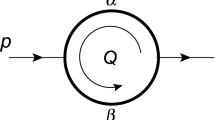Summary
Explicit sum over histories expressions for the transition amplitude are constructed on the basis of the canonical formalism of quantum mechanics. The sum over histories can be shown to coincide with the Feynman principle when the Hamiltonian is classical in form and quantization is carried out in terms of the commutators of operators. In general, the sum over histories differs somewhat from Feynman’s functional integral but still involves the exponential of the action,S = ∫(px − H) dt. However, for the Dirac field, where dynamical independence implies the anti-commutativity of operators, the sum over histories we construct has a form completely different from the Feynman principle.
Riassunto
Sulla base del formalismo canonico della meccanica quantistica si costruiscono per l’ampiezza di trasmissione espressioni composte da somme esplicite sulle storie. Si può dimostrare che la somma sulle storie coincide col principio di Feynman quando l’hamiltoniana ha la forma classica e la quantizzazione si esegue in termini dei commutatori degli operatori. In generate la somma sulle storie differisce alquanto dall’integrale funzionale di Feynman ma comprende ancora l’esponenziale dell’azioneS = ∫(px − H) dt. Tuttavia, per il campo di Dirac, in cui l’indipendenza dinamica implica l’anticommutatività degli operatori, la somma sulle storie che costruiamo ha forma completamente differente dal principio di Feynman.
Similar content being viewed by others
References
E. Schrödinger:Ann. der Phys.,79, 489 (1926);H. Goldstein:Classical Mechanics, Sect. 9-8 (Cambridge, Mass. 1950).
P. A. M. Dirac:Phys. Zeitz. Sowjetunion,3, 64 (1933);Quantum Mechanics, Sect. 32, third ed. (Oxford, 1947).
R. P. Feynman:Rev. Mod. Phys.,20, 367 (1948). See also:B. Davison:Proc. Roy. Soc., A225, 252 (1954);P. T. Matthews andA. Salam:Nuovo Cimento,2, 120 (1955).
J. Schwinger:Phys. Rev.,82, 914 (1951);91, 713 (1953).
F. J. Dyson:Advanced Quantum Mechanics, lecture notes, 1951.
J. C. Polkinghorne:Proc. Roy. Soc. (London), A230, 272 (1955).
K. Symanzik:Zeits. f. Naturf.,9a, 809 (1954).
R. P. Feynman:Phys. Rev.,84, 108 (1591).
G. Chrystal:Algebra, chap. XX (London, 1904).
J. Schwinger:Phys. Rev.,92, 1283 (1953).
Author information
Authors and Affiliations
Rights and permissions
About this article
Cite this article
Tobocman, W. Transition amplitudes as sums over histories. Nuovo Cim 3, 1213–1229 (1956). https://doi.org/10.1007/BF02785004
Received:
Published:
Issue Date:
DOI: https://doi.org/10.1007/BF02785004




